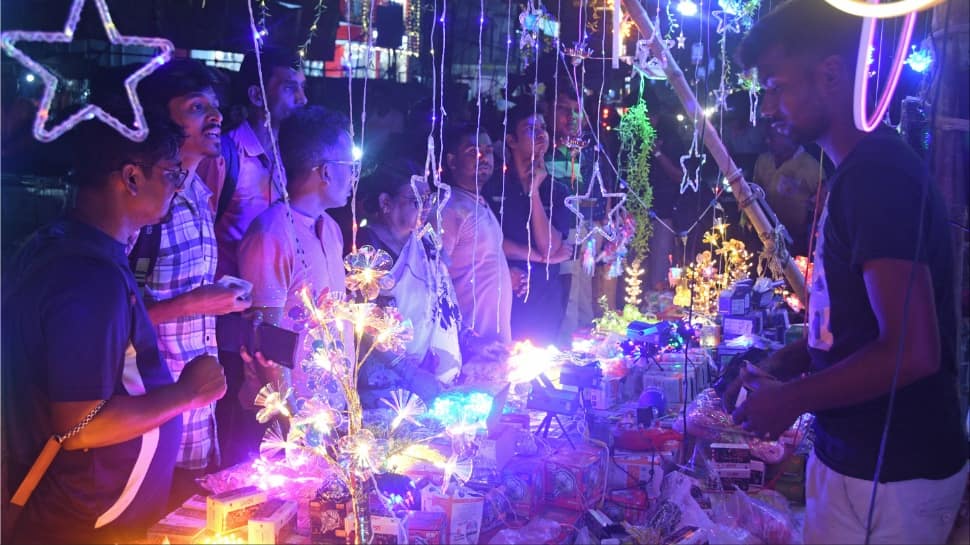**Diwali 2025: Imported Lights Illuminate India’s Festivities and Economic Dilemmas**
As Diwali approaches in 2025, millions of Indian homes prepare to celebrate the festival of lights, decorating their homes with shimmering LED strings, lanterns, and other electrical accessories. However, beneath the vibrant glow of these decorations lies a complex economic and industrial narrative that continues to challenge India’s ambitions of self-reliance and indigenous manufacturing.
### The Prevalence of Chinese Imports
Despite years of government campaigns urging citizens to “Make in India” and “Buy Swadeshi,” the reality on the ground tells a different story. A significant majority of Diwali lights and decorative accessories available in Indian markets are still imported from China. These imports not only dominate the shelves of urban and rural markets alike but also play a major role in India’s growing trade deficit with its northern neighbor.
A visit to Bhagirath Palace, Old Delhi’s largest electrical and hardware market, vividly illustrates the situation. Here, Chinese-made 10-meter LED string lights are the norm, easily available at wholesale prices ranging from Rs 95 to Rs 110 per string. In stark contrast, Indian-manufactured alternatives, though often praised for their superior build quality and durability, are priced significantly higher—around Rs 220 per string. This price gap has a direct impact on consumer choices, especially among the price-sensitive middle class that forms the bulk of Diwali shoppers.
### The Compatibility and Supply Chain Challenge
While a section of consumers is beginning to prefer Indian-made lights for their longer lifespan and better performance, practical issues persist. One major complaint among retailers and customers alike is the incompatibility between locally made lights and the connectors that are now standard in the market—most of which are Chinese. Indian manufacturers, lacking a coordinated supply chain, often produce lights whose plugs do not fit the widely available Chinese connector sockets. As a result, buyers are forced to resort to makeshift “jugaad” solutions, cobbling together connections to make Indian products work with existing infrastructure. This inconvenience further nudges customers toward the more compatible Chinese imports.
This seemingly minor detail points to a much larger systemic issue. China’s manufacturing ecosystem is highly integrated, with factories producing not just the final product but all related components—connectors, wiring, packaging, and even decorative elements. In contrast, Indian manufacturers tend to operate in silos, focusing on final assembly while neglecting the ancillary components that ensure product compatibility and convenience for the end user. The lack of an integrated supply chain and end-to-end product development is a fundamental reason why Indian-made lights struggle to gain market share, despite their perceived quality advantages.
### The Economic Impact: A Widening Trade Deficit
The dominance of Chinese festive lights is not just a matter of consumer preference or industrial capability—it has significant economic repercussions. According to a 2022 report by Global Times, China exported LED light-related products worth $710 million to India in the first half of that year alone, representing a 27% increase from the previous year. This surge in imports is a contributing factor to India’s ballooning trade deficit with China, which, by the 2025 financial year, has reached a staggering $99 billion.
Industry experts and Chinese analysts alike see little sign of change in the near future. Liu Zongyi, a researcher at the Shanghai Institutes for International Studies, remarked that India, despite its recent push to develop domestic manufacturing, still lacks the comprehensive industrial ecosystem that characterizes China. Factors such as a relatively unskilled labor force, insufficient support policies regarding land and taxation, and underdeveloped infrastructure continue to hamper India’s efforts to close the gap.
### The Plight of Indian Manufacturers
The situation for Indian manufacturers, particularly the micro, small, and medium enterprises (MSMEs) that form the backbone of the country’s manufacturing sector, is challenging. Many have found themselves unable to compete with the low prices and integrated supply chains of Chinese competitors. In a telling anecdote from Bhagirath Palace, association member Anup Yadav revealed that several Indian manufacturers have converted their warehouses into storage facilities for Chinese imports, as demand for Indian-made festive lights has dwindled. This shift not only reflects changing market realities but also signals lost opportunities for the domestic sector.
The data highlights a sobering reality: unless urgent reforms are enacted in areas such as land acquisition, labor regulation, and access to affordable capital, Indian businesses will continue to struggle—not

